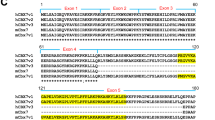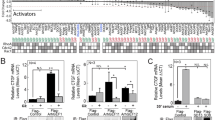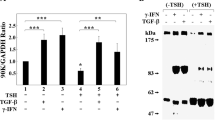Abstract
We previously reported that BARF1 gene has either an immortalizing effect, when expressed in primary primate epithelial cells, or a malignant transforming activity, when expressed in established and nontumoral rodent fibroblast or human B-cell lines. As predicted from sequence analysis, we found that BARF1 coded protein can be secreted from different cell lines, among them BARF1-transfected Balb/c3T3 rodent fibroblasts. Thus, as an initial step to clarify BARF1 oncogenic functions, we investigated whether the secreted form of BARF1 protein can activate the cell cycle as a growth factor. Since efficient BARF1 expression could be obtained from 293-tTA cells infected with a tetracycline-regulatable recombinant adenovirus, secreted BARF1 product could be purified from the culture medium of such cells by ammonium sulfate precipitation, ion exchange chromotography and sucrose gradient sedimentation. We describe in this paper that addition of a purified product of secreted BARF1 protein to serum-free culture medium of Balb/c3T3 rodent fibroblasts, human Louckes B-cell line and primary monkey kidney epithelial cells resulted in a cell cycle activation that was inhibited by affinity-purified anti-BARF1 antibody. Our demonstration of a specific stimulation of cell cycle in vitro by BARF1 secreted product suggests that this EBV-encoded BARF1 protein could act as a growth factor in vivo.
This is a preview of subscription content, access via your institution
Access options
Subscribe to this journal
Receive 50 print issues and online access
$259.00 per year
only $5.18 per issue
Buy this article
- Purchase on Springer Link
- Instant access to full article PDF
Prices may be subject to local taxes which are calculated during checkout





Similar content being viewed by others
References
Cohen J and Lekstrom K . (1999). J. Virol., 73, 7627–7632.
Danve C, Decaussin G, Busson P and Ooka T . (2001). Virology, 288, 223–235.
Decaussin G, Sbih-Lammali F, De Turenne-Tessier M, Bouguermouh AM and Ooka T . (2000). Cancer Res., 60, 5584–5588.
Gao Y, Lu YJ, Xue SA, Chen H, Wedderburn N and Griffin BE . (2002). Oncogene, 21, 825–835.
Hayes DP, Brink AA, Vervoort MB, Middeldorp JM, Meijer CJ and van den Brule AJ . (1999). Mol. Pathol., 52, 97–103.
Karran L, Teo CG, King D, Hitt MM, Gao Y, Wedderburn N and Griffin BE . (1990). Int. J. Cancer, 45, 763–772.
Kieff E . (1996). Fields Virology, Fields BN, Knipe DM and Howley PM (eds.) 3rd edn. Lippincott-Raven Publishers: Philadelphia, PA (chapter 74), pp. 2343–2394.
Massie B, Mosser DD, Koutroumanis M, Vitté-Mony I, Lamoureux L, Couture F, Paquet L, Guilbault C, Dionne J, Chahla D, Jolicoeur P and Langelier Y . (1998). Cytotechnology, 28, 53–64.
Nishikawa J, Imai S, Oda T, Kojima T, Okita K and Takada K . (1999). J. Virol., 73, 1286–1292.
Ooka T . (2001). EBV. Rep., 8, 177–182.
Rickinson AB and Kieff E . (2002). Fields Virology, Fields BN, Knipe DM and Howley PM (eds.), 4th edition Lippincott-Raven Publishers: Philadelphia, PA, pp. 257–2627.
Sbih-Lammali F, Bouguermouh AM, Decaussin G and Ooka T . (1996). J. Med. Virol., 49, 7–14.
Sheng W, Decaussin G, Ligout A, Takada K and Ooka T . (2003). J. Virol., 77, 3859–3865.
Sheng W, Decaussin G, Sumner S and Ooka T . (2001). Oncogene, 20, 1176–1185.
Strockbine LD, Cohen JI, Farrah T, Lyman SD, Wagener F, DuBose RF, Armitage RJ and Spriggs MK . (1998). J. Virol., 72, 4015–4021.
Tanner JE, Wei MX, Ahamad A, Alfieri C, Tailor P, Ooka T and Menezes J . (1997). J. Infect. Dis, 175, 38–46.
de Turenne-Tessier M, Jolicoeur P, Middeldorp J and Ooka T (Submitted).
Wei MX, de Turenne-Tessier M, Decaussin G, Benet G and Ooka T . (1997). Oncogene, 14, 3073–3082.
Wei MX, Moulin JC, Decaussin G, Berger F and Ooka T . (1994). Cancer Res., 54, 1843–1848.
Wei MX and Ooka T . (1989). EMBO J., 8, 2897–2903.
Xue SA, Labrecque LG, Lu QL, Ong SK, Lampert IA, Kazembe P, Molyneux E, Broadhead RL, Borgstein E and Griffin BE . (2002). Int. J. Cancer, 99, 635–643.
Zhang CX, Decaussin G, Finerty S, Morgan A and Ooka T . (1992). Virus Res., 26, 153–166.
Zur Hausen A, Brink AA, Craanen ME, Middeldorp J, Meijer CJ and van Den Brule AJ . (2000). Cancer Res., 60, 2745–2748.
Acknowledgements
This work was supported by Grants Nos. 4486 and 3381 from the ARC (Association pour la Recherche contre le Cancer) and Ligue National contre le Cancer (Comité du Rhône).
Author information
Authors and Affiliations
Corresponding author
Rights and permissions
About this article
Cite this article
Sall, A., Caserta, S., Jolicoeur, P. et al. Mitogenic activity of Epstein–Barr virus-encoded BARF1 protein. Oncogene 23, 4938–4944 (2004). https://doi.org/10.1038/sj.onc.1207607
Received:
Revised:
Accepted:
Published:
Issue Date:
DOI: https://doi.org/10.1038/sj.onc.1207607
Keywords
This article is cited by
-
BARF1 gene silencing triggers caspase-dependent mitochondrial apoptosis in Epstein-Barr virus-positive malignant cells
Journal of Biosciences (2015)
-
Allosteric competitive inactivation of hematopoietic CSF-1 signaling by the viral decoy receptor BARF1
Nature Structural & Molecular Biology (2012)
-
Conserved mutation of Epstein-Barr virus-encoded BamHI-A Rightward Frame-1 (BARF1) gene in Indonesian nasopharyngeal carcinoma
Infectious Agents and Cancer (2010)
-
Cyclin D1 expression is induced by viral BARF1 and is overexpressed in EBV-associated gastric cancer
Virchows Archiv (2008)
-
Biochemical and functional characterization of Epstein–Barr virus-encoded BARF1 protein: interaction with human hTid1 protein facilitates its maturation and secretion
Oncogene (2006)



